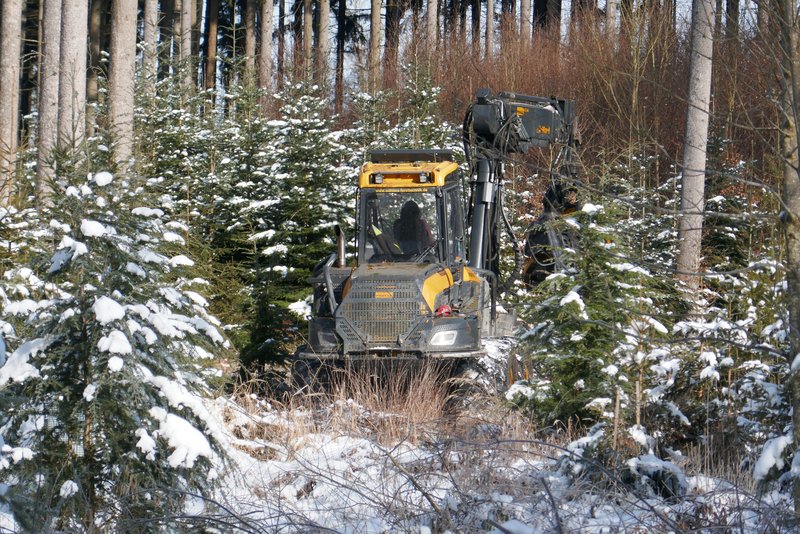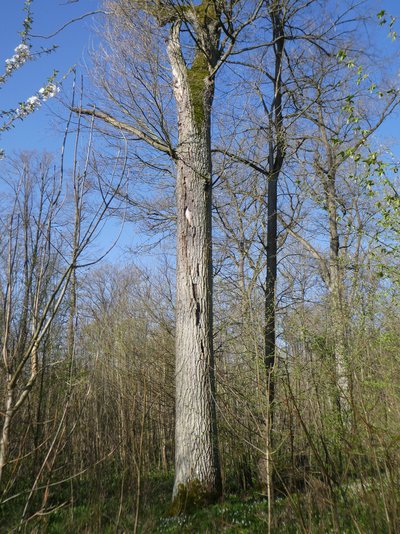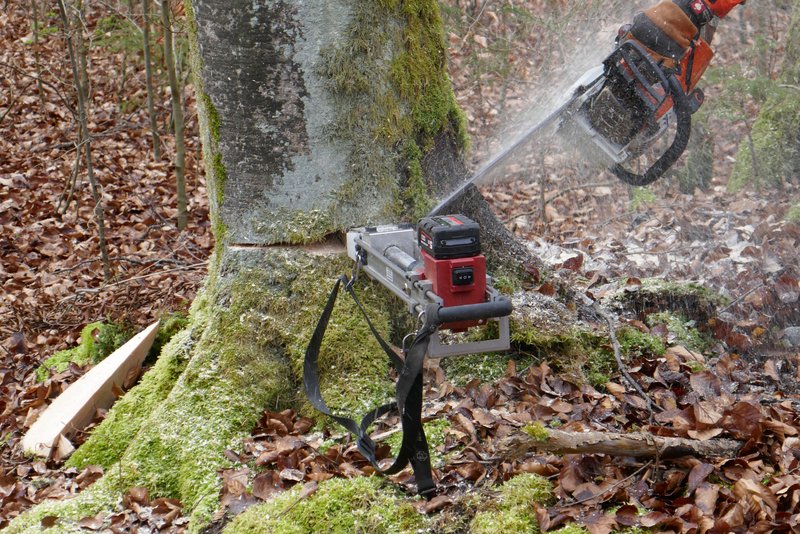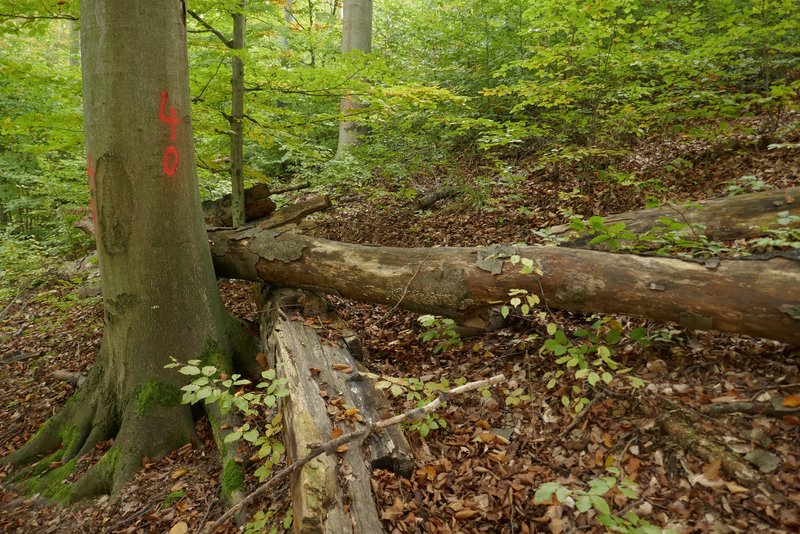Forestry in Germany is increasingly taking into account the need to protect biodiversity by leaving biotope or habitat trees and lying deadwood in the forest. Clear-cuts are avoided by making flowing transitions between forest generations possible. This leads to the development of vertically structured forests that do not allow for wide open views. Driving on the forest area is to be kept to a minimum, so skid trails are often laid out at such wide distances that some of the trees are out of the boom reach of forestry machines.
These forest structures make forest operations more difficult. “BestHarvest” is a collaborative project between the Kuratorium für Waldarbeit und Forsttechnik e.V. (Board of Trustees for Forest Work and Technology), the company Unique land use GmbH, and the Bayerische Landesanstalt für Wald und Forstwirtschaft (Bavarian State Institute of Forestry). It investigates how timber harvesting methods can be adapted to these challenges. The project focused on the following aspects:
- Distances between skid trails that exceed boom reach
- View obstruction by regeneration or other obstructive vegetation
- Hazards caused by falling tree parts from habitat trees
- Lying deadwood or vegetation that hinders walking
Investigation method
In the states of Baden-Württemberg, Bavaria and Thuringia, standardised interviews and workshops were conducted with experts from state forestry enterprises, machine bases and forest companies to find out how their working practices can be adapted to these challenges. In addition to this, eleven case studies were carried out on timber harvesting measures in structurally rich forest stands.
In the course of these studies, the characteristics of the stand overall were recorded, and of the trees removed in particular. In addition to the tree species and diameter, the occurrence of habitat trees, vegetation that obstructed visibility, lying deadwood and ground cover was recorded in each of four segments of a circle with a radius of 10 m around each tree. The distance of the trees for removal to the next skid trail was also measured, and the trees were marked with numbers. The logging operations were filmed using action cameras. These were attached to the chests of the chainsaw operators or in the operator's cabins of the forestry machines.
On the basis of the videos, the time required was determined, separately for each section of the workflow. Generalised linear models (GLM) were used to search for correlations at the individual tree level between the working time required and the structural characteristics of the trees for removal and their surroundings. The most important results are presented below, separately for each of the aspects investigated.
Distances between skid trails
The most efficient and safest timber harvesting method is without a doubt fully mechanised timber harvesting with a harvester. If the distance between skid trails is so large that not all the trees are within the boom reach, a combination of motor-manual and mechanical logging procedures is used. The chainsaw operators and the harvesters can work at the same time or at different times. The distribution of the work steps between people and machines may vary. In two case studies, a forest worker and the harvester worked simultaneously on the area. The work of the forest workers was limited to felling. In comparison with two case studies using fully mechanised harvesting, it is striking that in the case studies with combined motor-manual and machine processing, there were several periods of waiting for the harvester (23 % and 13 % of the total working time).
Regeneration and other vegetation that obstructs visibility
Measures to deal with visual obstruction start when the trees are being marked for felling. In two case studies in Baden-Württemberg, the position coordinates of the trees for removal were also recorded when they were being marked. The forest workers were able to locate the trees with the help of an app when it came to the felling operation. The “tree finding” working step then did not take any longer for trees obscured by a lot of regeneration than if they were freely visible. In both cases, an average of 1.5 minutes per tree was recorded for marking them. As a further measure, the colour marking was to be applied at a sufficient height on the trees. To improve work safety in the case of regeneration obstructing the visibility of the trees, permanent voice contact should be available via helmet radio between the chainsaw operators. If they are working at the same time as the harvester, an electronic warning system can warn the harvester operator when forest workers enter the machine’s danger zone.
In the case studies with people and machines working simultaneously, the view of the base of the trunk of the trees was in many cases obstructed by regeneration. In one case, only 5% of the trees within the reach of the crane were felled by the harvester; in the other case it was 72%. We recommend the use of technology such as camera support or sensor-based systems that allow partial automation of the gripping and felling process to overcome the obstruction of visibility by vegetation during machine felling operations and to achieve a higher rate of machine felling.
In both case studies, the time required for clearing vegetation around the tree for removal before felling was significantly greater when there was regeneration obscuring visibility in the vicinity. Caution is called for with statistical evaluations for sub-processes, because these are not independent of each other. If the sub-processes require only a little time, however, there are often no noticeable differences in total time consumption. These differences can nevertheless be significant for the qualitative assessment. The time spent for entering the escape route and staying in the safe area during motor-manual felling thus always accounts for only a small proportion of the total time consumption. For work safety, however, the entering of the escape route is extremely important. In one case, the time required by the chainsaw operator for entering and staying in the escape route was significantly less, the more visibility-obstructing regeneration there was in the vicinity. In the other case, the forest worker did not enter the escape route at all, thereby taking a considerable risk and violating the accident prevention regulations. When a machine is waiting for a tree to be felled towards the skid trail, and dense regeneration vegetation makes it more difficult for the chainsaw operators to withdraw, they may be more inclined to ignore safety precautions.
This is avoided when the Königsbronn logging method for big softwood is used (“KSV”, for “Königsbronner Nadelstarkholzverfahren”). In this case, forest workers and the harvester work at different times. This procedure aims to cause as little damage as possible to the regeneration. The forest workers fell two to three trees at a time on top of each other on felling lines diagonal to the skid trail, so that the crowns fall as far as possible on to the skid trail. The trunks are delimbed with a chainsaw and the crown is cut off. The harvester arrives later, hauls the long-length logs out of the stand to the skid trail and processes the tops. As the forest workers start felling at the trees standing closest to the skid trail, they have to fell all the trees motor-manually. This means that the most dangerous step in the process continues to be carried out by the forest workers. In the KSV case study, almost 90% of the trees were actually within the boom reach of the harvester. The total time consumption was significantly longer, the more regeneration there was around the trees. This was because of more time being required for clearing and processing.
For an average tree, the time required was 32 % longer when there was regeneration all around, compared to trees without regeneration. In a motor-manual felling operation carried out in a mature beech-oak stand, the total working time was also 27 % longer when there was regeneration obstructing visibility all around. Weinbrenner et al. discussed the causes of occupational accidents during forestry operations in group discussions with forest workers. It emerged that obstructive vegetation is a considerable problem in the daily work of these people. “This frequently getting stuck and slipping in the vegetation, often accompanied by minor injuries (such as skin scratches) - it all makes the work more difficult and is a source of frustration in our day-to-day work.”
Habitat trees
In addition to the factor of “accidents caused by poor visibility due to vegetation”, Weinbrenner et al. name “being hit by falling deadwood during felling operations” as one of three typical types of accident. From the forest workers' point of view, this is the greatest danger in forest work.
In some cases, significant correlations were found in the case studies between the time required for individual time elements and the occurrence of habitat trees, even if this did not prove to be significant in the overall time required. In one case study, the time taken to find the trees and time spent for entering the escape route and staying in the safe area was longer, and in two others, more time was spent clearing the area around the trees. More time spent on these steps may reflect a greater degree of caution wherever there are habitat trees in the vicinity. As these sub-processes only make up a small share of the total time consumption, the effect was not visible there. In two case studies, no correlations were observed, although there were at least a few individual habitat trees in the vicinity. In both cases, the stands involved were predominantly coniferous. As “dead-branch keepers”, conifers probably pose less of a danger than most deciduous tree species.
In two case studies, there were significant correlations with the total time consumption. The effect of the habitat trees in the vicinity of the trees to be felled motor-manually was surprising in these cases. The project team would actually have expected a greater time requirement where there were habitat trees in the vicinity. In fact, the time consumption in these case studies was shorter when there were such trees nearby.
This was due to the shorter time spent for processing the timber. If this should indeed be due to the fact that forest workers avoid staying under habitat trees for long because of the risk of falling branches, and the care taken in the forestry work possibly suffers as a result, this would be a cause for concern. This would mean that they experience stress, which could increase the risk of accidents and, even if no accident occurs, can be harmful to health if prolonged.
In terms of procedural measures to avoid accidents caused by falling tree parts, the following hierarchy generally applies:
- The safest method is fully mechanised felling with a harvester. In this procedure, the person carrying out the work is not in the immediate vicinity of the tree and is protected from falling tree parts by the machine cabin.
- However, where motor-manual felling is unavoidable, the felling should be carried out with the help of a winch if there is a risk of falling tree parts.
- If this is also not possible, the trees should be brought down using a remote-controlled felling wedge. It should be noted that remote-controlled felling wedges may only be used to fell trees that could theoretically also be felled using conventional felling wedges. This means: no big trees leaning back, and no trees that are rotten. In addition to a considerably reduction of vibrations during felling, these felling wedges also have ergonomic advantages over traditional wedges driven using an axe.
Lying deadwood
A correlation between lying deadwood and the time required for motor-manual work was only found for one of the combined methods. With this method, trees were more often felled motor-manually when there was a lot of lying deadwood in the vicinity. Otherwise, motor-manual logging was not hindered by lying deadwood, at least not to the extent that this would have been noticeable in terms of the time required. Nevertheless, this factor should not be underestimated. Weinbrenner et al. (2019) give “tripping and falling over deadwood lying around” as the third most typical type of accident.
Lying deadwood could be expected to have an impact on the time required for hauling logs to the skid trail. After all, work with the cable winch also involves long walking distances. In the case studies, the logs extracted to the forest road could only rarely be assigned to specific trees removed, so that a statistical evaluation of this effect was not possible.
Conclusions
The procedural measures for dealing with the challenges presented by conservation-related forest structures for timber harvesting are limited. As a result of the project, a review of silvicultural concepts is thus recommended. In the interviews conducted by Weinbrenner et al., the forest workers expressed a great lack of comprehension for the current silvicultural concepts. “In other fields of work, if there was a risk of accidents, people would try to make the working site safer (...) In the forest workplace, the opposite is the case.”
The skid trail spacing in particular should be brought in line with the physical safety requirements of the people working in the forest. The technical possibilities for making timber harvesting safer and more efficient even in conditions where visibility is impaired need to be developed further. Where fully mechanised timber harvesting is still not possible over a large area, the “hazard trees” should, from the work safety point of view, at least no longer be single trees distributed over the area, but trees concentrated in groups, although not every tree with a woodpecker cavity is a hazard tree. Habitat trees should be differentiated accordingly. In the case of hazard trees, however, it would be better to meet nature conservation requirements for standing deadwood by separating smaller areas of commercially used forest without and smaller areas of unmanaged zones with standing deadwood.
The “BestHarvest” project was supported with funds from the Federal Ministry of Food and Agriculture (BMEL) via the Agency of Renewable Resources (Fachagentur Nachwachsende Rohstoffe e. V.) as the BMEL's project management agency for the Renewable Resources funding programme.




